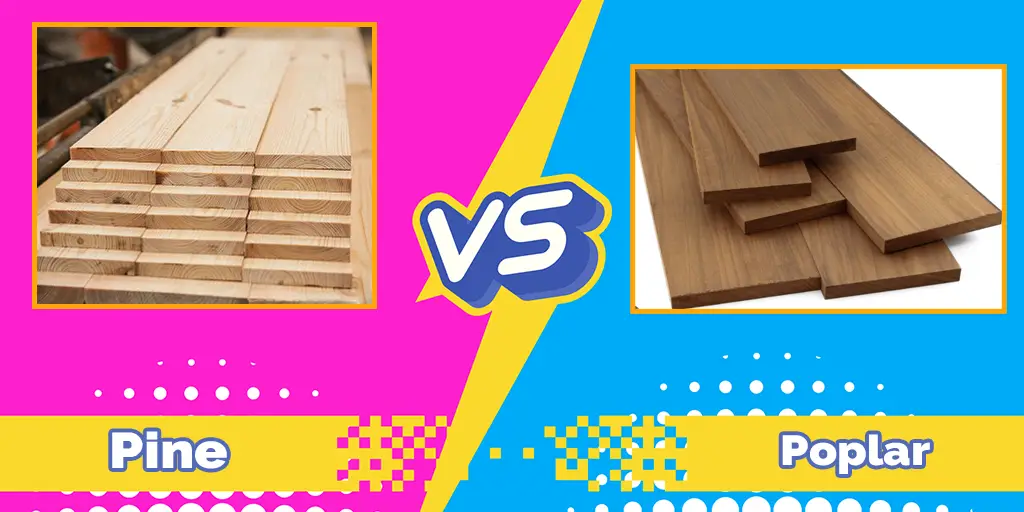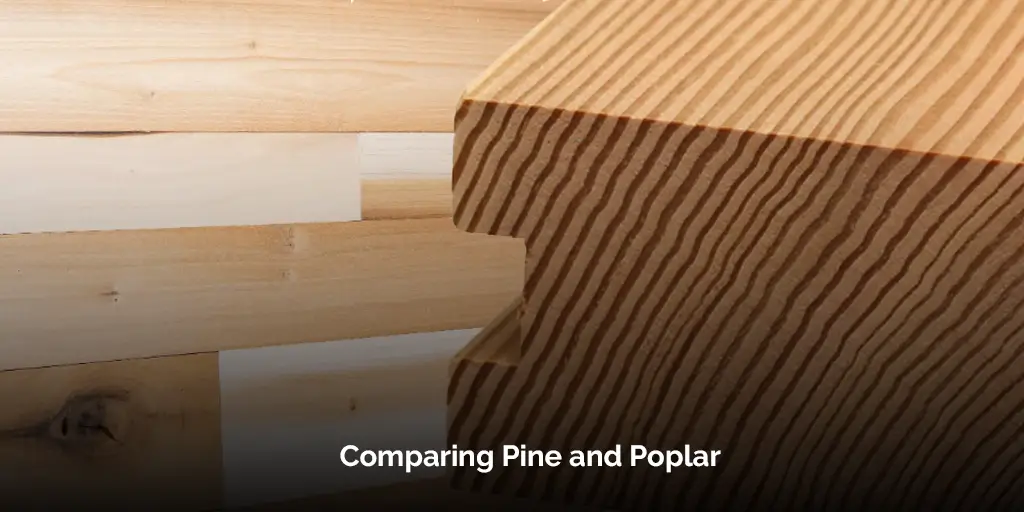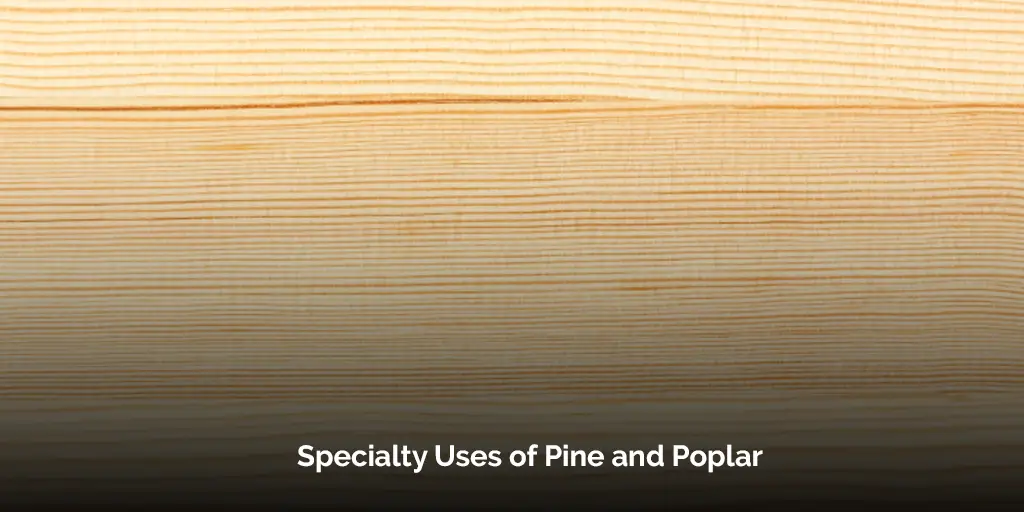When embarking on a woodworking project, the choice of wood is as crucial as the design itself. It’s not just about aesthetics; it’s about workability, durability, cost, and the final purpose of the piece.
For both budding and experienced woodworkers, two accessible and popular choices often come to mind: Pine and Poplar.

These two types of wood, each with their unique characteristics, open up a world of possibilities for projects ranging from rustic furniture to elegant interior trim.
Pine, with its warm hues and soft texture, invites a sense of natural beauty into any piece. Poplar, on the other hand, offers a harder surface and a more subtle color palette, making it a go-to for more functional items.
In this comprehensive guide, we will dive deep into the “Pine Vs Poplar” debate. We’ll explore the nuances of each wood type, comparing their workability, cost, finishing, and the best uses for each.
Whether you’re a beginner looking to start your first project or a seasoned woodworker considering your next creation, this guide will provide you with the insights you need to make an informed choice.
Pine and Poplar: Key Differences and Similarities
General Characteristics of Pine
Pine, a versatile and popular softwood, stands out for its ease of work and wide range of applications, from interior construction to decorative projects.
Let’s delve into the diverse types of pine, highlighting their distinct traits and suitability for different woodworking endeavors.
Types of Pine and Their Properties:
- Eastern White Pine: Known for its straight grain and fine texture, Eastern White Pine is a top choice for intricate woodworking projects.
- Western White Pine: This variety strikes a balance between workability and strength, making it suitable for both interior construction and decorative pieces.
- Sugar Pine: Recognized for its coarse texture, Sugar Pine is often used in larger projects, where its strength and durability are paramount.
The softer varieties of pine, including Southern Yellow Pine, are known for their straight grain and uniform texture, making them ideal for projects where a smooth finish is desired.
However, when considering outdoor use, pressure treated pine wood, treated with chromate copper arsenate, becomes essential to ensure durability against the elements.
General Characteristics of Poplar
Poplar, a unique hardwood, is often underestimated due to its softness compared to other hardwoods like Red Oak.
Its workability and diverse coloration make it a compelling choice for various woodworking projects.
Poplar’s Distinct Features:
- Color Variations: Poplar wood can display a range of colors, including light brown, dark green, and even black in its heartwood, offering a unique aesthetic appeal.
- Strength and Workability: While not as strong as some other hardwoods, poplar wood is strong enough for many applications, especially where straight grain and ease of work are priorities.
- Utility in Woodworking: Poplar is commonly used in interior construction due to its balance of strength and workability.
Despite its strengths, poplar wood vs pine often becomes a consideration due to the difference in their staining properties.
While pine wood can be challenging to stain evenly, using a pre-stain wood conditioner can significantly improve the results, offering a more uniform and appealing finish.
Understanding the unique characteristics of both pine and poplar is crucial for woodworkers.
Whether choosing the soft pine varieties like Eastern White Pine and Western White Pine or the more robust Southern Yellow Pine and Western Yellow Pines, each wood species brings its own set of qualities to the table.
Similarly, poplar, with its unique color variations and strength, provides a versatile option for various woodworking projects.
Comparing Pine and Poplar: Workability, Durability, and Cost

Workability and Durability
Pine Wood: Ease and Versatility
Pine is renowned for its ease of work, making it a favorite among beginners and experts alike.
The straight grain of varieties like Eastern White Pine and Western White Pine ensures smooth cutting and shaping, ideal for intricate designs and detailed woodworking.
In terms of durability, soft pine species like Southern Yellow Pine offer a decent balance between strength and workability.
However, for outdoor projects, pressure treated pine wood is recommended, as it withstands environmental stressors better, thanks to its treatment with substances like chromate copper arsenate.
Poplar Wood: Strong Yet Manageable
Poplar wood, while strong, remains surprisingly easy to work with. Its strength is more akin to hardwoods like Red Oak but without the challenging density.
This makes poplar an excellent choice for interior construction projects where durability is needed, but the ease of work is also a priority.
The straight grain of poplar contributes to its manageability, allowing for clean cuts and minimal splintering.
Cost Considerations
Pricing of Pine Woods
Pine is generally more affordable than many hardwoods, making it a cost-effective option for a wide range of projects.
The price can vary depending on the type of pine and its treatment; for example, pressure treated pine wood may be more expensive due to the additional processing it undergoes.
However, even higher-grade pines like Southern Yellow Pine tend to be more budget-friendly compared to many hardwoods.
Cost of Poplar Wood
Poplar, while a hardwood, is typically less expensive than other hardwoods like Red Oak. This cost-effectiveness, combined with its strength and workability, makes poplar a popular choice for both DIYers and professional woodworkers.
It offers the durability of a hardwood without the hefty price tag that usually accompanies hardwoods.
Aesthetic and Finishing
Staining Pine
Pine stain can be abit tricky, as it tends to absorb stain unevenly. However, this can be mitigated by using a pre-stain wood conditioner, which helps in achieving a more uniform and appealing finish.
The natural beauty of pine, especially varieties like Eastern White Pine and Western White Pine, is often highlighted with light stains or clear finishes that emphasize their straight grain and warm hues.
Finishing Poplar
Poplar wood’s varied hues, from light brown to dark green, offer a unique aesthetic. However, like pine, it can also be challenging to stain evenly. For a more consistent finish, it is advisable to use a pre-stain wood conditioner.
Often, poplar is painted, which masks the uneven color absorption and brings a uniform look to the finished product.
When comparing “Pine Vs Poplar,” the choice often boils down to the specific requirements of the project. Pine offers ease of work and a rustic charm, while poplar brings strength and a unique color palette.
Both woods are budget-friendly and have their own set of considerations when it comes to finishing and aesthetics.
Specialty Uses of Pine and Poplar

Pine in Detail: Versatile Applications
Ideal Projects for Pine
Pine’s versatility makes it suitable for a wide array of woodworking projects. Here are some specific applications:
- Decorative Items: Thanks to its aesthetic appeal, particularly in varieties like Eastern White Pine, pine is often used for decorative items like picture frames and paneling.
- Furniture Making: The workability of pine, especially the softer varieties like Southern Yellow Pine, makes it a popular choice for crafting furniture.
- Outdoor Constructions: When pressure treated, pine wood becomes resilient against rot and decay, making it ideal for outdoor projects like decking and garden furniture.
Handling Pine’s Resinous Nature
While working with pine, particularly the soft pine species, woodworkers often encounter its resinous nature.
This resin can clog tools but can be managed with regular cleaning and maintenance of the tools. For those sensitive to pine resins, appropriate protective gear is recommended.
Special Considerations for Outdoor Use
For outdoor applications, pressure treated pine wood is a must. It undergoes treatment with chemicals like chromate copper arsenate, enhancing its resistance to rot, pests, and weather-related wear.
This treatment extends the life of pine in outdoor settings, ensuring durability and longevity.
Poplar in Detail: Strength and Aesthetics
Ideal Uses for Poplar
Poplar wood, while not as visually striking as some other woods, has its own set of strengths:
- Interior Construction: Due to its ease of work and straight grain, poplar is frequently used in interior construction, including cabinetry and trim work.
- Painted Projects: Poplar’s ability to take paint well makes it a preferred choice for projects that require a painted finish.
- Utility Items: Its strength, coupled with workability, makes poplar a great choice for utility items like shelves and frames.
Techniques for Managing Poplar’s Texture
Poplar wood can exhibit a “fuzziness” when cut or sanded. To achieve a smooth finish, it’s crucial to use sharp tools and progressively finer sandpaper.
Pre-stain wood conditioner can be used to minimize uneven stain absorption, though painting is often the preferred method for finishing poplar due to its uneven coloration.
Both pine and poplar woods have their unique advantages and ideal uses. Pine, with its rustic charm and ease of work, is perfect for a range of projects from furniture to outdoor constructions.
Poplar, on the other hand, offers a balance of strength and workability, ideal for interior construction and utility projects.
Making the Right Choice: Pine vs Poplar for Your Project
When it comes to woodworking, choosing the right wood is crucial. Let’s explore the factors that will guide you in making the best choice between pine and poplar for your specific project needs.
Factors to Consider in Your Selection
Project Type and Desired Outcome
- Pine: Ideal for rustic, warm projects, and where a natural wood appearance is preferred. Excellent for decorative items, furniture, and when pressure-treated, suitable for outdoor applications.
- Poplar: Better suited for projects that require painting or where a harder wood is needed. Commonly used for interior construction, cabinetry, and utility items.
Skill Level and Tools Available
- Ease of Work: Both pine and poplar are easy to work with. Pine might be slightly easier for beginners due to its softness, while poplar offers a bit more resistance without being overly hard.
- Tool Requirements: Sharp tools are essential for both, but especially for poplar to avoid fuzziness after cutting.
Environmental Considerations and Longevity
- Durability in Different Environments: Pressure-treated pine is more durable outdoors, while poplar is better for indoor use where its hardness is an advantage.
- Long-Term Maintenance: Pine may require more maintenance, especiallyif it’s not pressure-treated. Poplar typically requires less upkeep, making it a practical choice for busy woodworkers.
Personal Experiences and Recommendations
Pros and Cons Based on Real-World Usage
- Pine: Loved for its aesthetic and ease of work, but can be problematic if not treated properly for outdoor use.
- Poplar: Appreciated for its strength and paintability but can be less visually appealing due to its color variations.
Recommendations for Different User Levels
- Beginners: Pine is generally recommended for those starting in woodworking due to its forgiving nature.
- Experienced Woodworkers: Poplar can be a good choice for more complex projects that require a harder wood with straightforward workability.
Choosing between pine and poplar depends on the specific requirements of your project, your skill level, and the tools you have.
Both woods have their unique advantages and limitations. Pine is great for a rustic look and ease of work, while poplar offers a blend of strength and versatility, especially for painted projects.
Additional Resources and Tips for Woodworking with Pine and Poplar
Advanced Techniques and Tips for Working with Pine and Poplar
Pine Woodworking Techniques
- Pre-Stain Conditioning: To ensure even staining on pine, apply a pre-stain wood conditioner. This helps prevent blotchy or uneven stain absorption, a common issue with softer woods.
- Handling Resins: When working with resinous pines, like Southern Yellow Pine, ensure your tools are regularly cleaned to prevent resin buildup.
- Outdoor Projects: For outdoor pine projects, use pressure-treated pine to ensure longevity and resistance to weathering and pests.
Poplar Woodworking Techniques
- Smooth Finishing: Achieve a smooth finish on poplar by using sharp tools and fine-grit sandpaper. This helps reduce the fuzziness often associated with cutting and sanding poplar.
- Paint Finishing: Given poplar’s uneven stain absorption, consider using paint for a more uniform finish. A primer can be applied before painting to enhance the final look.
Further Reading and Learning Resources
- Books and Online Resources: There are numerous books and online resources available for woodworkers looking to deepen their understanding of different wood types and techniques. Topics range from basic woodworking skills to advanced project designs.
- Community Forums and Workshops: Joining woodworking forums or participating in workshops can be incredibly beneficial. Sharing experiences with other woodworkers and learning from their insights can enhance your skills and knowledge.
People who want to read this article: Poplar vs Oak: Which is More Appropriate for Your Project?
Maintaining and Caring for Pine and Poplar Projects
- Regular Maintenance: Both pine and poplar projects may require periodic maintenance, such as refinishing or sealing, to maintain their appearance and structural integrity.
- Environmental Protection: Particularly for pine, ensure that any outdoor projects are adequately protected against the elements. Regular checks for signs of wear or damage can help prolong the life of your project.
Working with pine and poplar can be a rewarding experience for woodworkers of all skill levels.
By understanding the unique properties of each wood and applying the appropriate techniques, you can create beautiful and lasting projects.
This section has provided additional resources and practical tips to help you excel in your woodworking endeavors with these two popular wood species.



